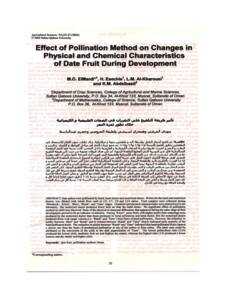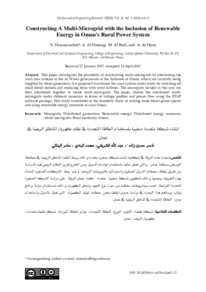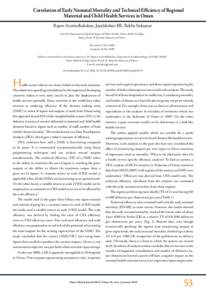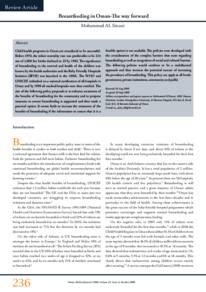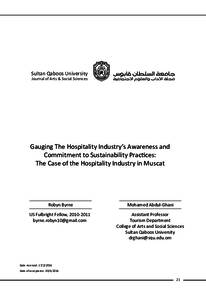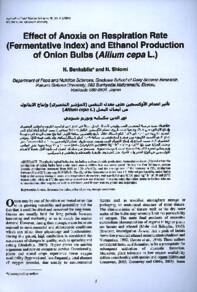Document
Effect of pollination method on changes in physical and chemical characteristics of date fruit during development.
Contributors
Publisher
Sultan Qaboos university
Gregorian
2002
Language
English
English abstract
Date palms were pollinated by hand, hand duster and motorized duster. Pollen for the hand and motorized dusters was diluted with wheat flour each at 1:5, 1:7, 1:9 and 1:14 ratios. Fruit samples were collected during 'Hababook', Kimri', 'Bisir', 'Rutab', and 'Tamr' stages. Chemical and physical characteristics were determined in the laboratory. The motorized duster produced lower fruit set than the hand duster. No significant effect of pollination method on yield was observed. None of the physical or chemical differences that appeared during the same stage of fruit development proved to be an indicator of maturity. During 'Kimri', more fruits with higher pectin (late maturing) were produced by the motorized duster than those produced by hand pollination and hand duster. But the motorized duster produced fruits with larger volume (i.e. 'Rutab' and 'Tamr') than those of hand pollination. However, the reduction in acidity between 'Bisir' and 'Rutab' and in volume between 'Rutab' and 'Tamr' clearly indicated early maturity of the hand-pollinated fruits. The reduction in acidity between 'Rutab' and 'Tamr' indicated that hand-pollinated fruits ripen at a slower rate than the fruits of mechanized pollination at any of the pollen to flour ratios. The latter case could be attributed to the conversion of the acids to the dark pigmentation of 'Tamr'. The lowest pollen: flour ratio (1:14) produced the lowest yield, moderate fruit set and highest dry matter, whereas the highest ratio (1:5) produced a lower sucrose and dry matter and higher yield.
Member of
ISSN
2410-1079
Resource URL
Citation
EIMardi, M. O., Esechie, H., AI-Kharousiyah, L. M., & Abd elbasit, K. M. (2002). Effect of pollination method on changes in physical and chemical characteristics of date fruit during development. Journal of Agricultural and Marian Sciences, 7 (1), 21-27.
Arabic abstract
تم تلقيح أشجار النخيل بواسطة اليد وملقحتين يدوية وميكانيكية. وقد خلطت حبوب اللقاح للاستعمال في الملقحتين بدقيق القمح بالنسية 5 : 1 و 7 : 1 و 9 : 1 و 14 : 1. تم جمع عينات الثمار في مراحل الهبابوك والكمري والبسر والرطب والتمر وأجريت عليها دراسة الصفات الكيميائية والطبيعية داخل المختبر. كانت نسبة عقد الثمار للملقحة الميكانيكية أقل عن النسبة التي أعطتها الملقحة اليدوية. لم تكن هناك فروقات معنوية من حيث تأثير طريقة التلقيح على الإنتاج. لم يثبت أن أي من الفروقات الكيميائية والطبيعية التي ظهرت أثناء المرحلة ذاتها يمكن أن تكون مؤشرا للنضج. ففي مرحلة الكمري احتوت الثمار على نسبة أعلى من البكتين (متأخرة النضج) باستخدام الملقحة الميكانيكية إذا ما قورنت بالتلقيح باليد والملقحة اليدوية. ولكن الملقحة الميكانيكية أعطت ثمارا أكبر حجما في مرحلتي البسر والرطب مقارنة بالملقحة اليدوية بينما اعتبر النقص في الحموضة في الثمار بين مرحلتي البسر والرطب والنقص في حجم الثمار بين مرحلتي الرطب والتمر مؤشرات للنضج المبكر للثمار المنتجة بواسطة التلقيح اليدوي. لكن النقص في الحموضة بين مرحلتي الرطب والتمر يشير إلى أن الثمار المنتجة بواسطة التلقيح اليدوي تنضج بسرعة أقل عن تلك المنتجة بواسطة التلقيح الميكانيكي بغض النظر عن نسب خليط حبوب اللقاح مع الدقيق. و يمكن اعتبار الحالة الأخيرة ناتجة عن تحول الأحماض إلى الصبغة الداكنة في مرحلة التمر. وقد أعطت نسبة 14 : 1 (دقيق : حبوب لقاح) إنتاجا أقل وكان عقد الثمار وسطا وأعلى في المادة الجافة وكان الإنتاج مرتفعا بينما أعطت النسبة 5 : 1 نسبة أقل من سكر القصب والمادة الجافة مع زيادة في الإنتاج.
Category
Journal articles

